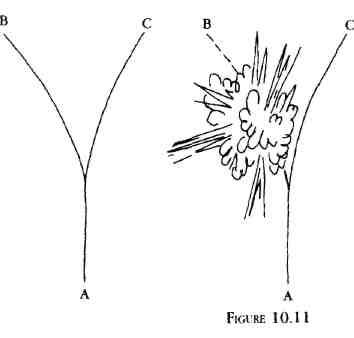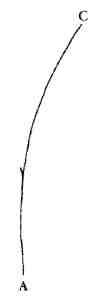Darwin's Dangerous Idea (55 page)
Read Darwin's Dangerous Idea Online
Authors: Daniel C. Dennett

290 BULLY FOR BRONTOSAURUS
Punctuated Equilibrium: A Hopeful Monster
291
but only represents the proper scaling of ordinary events into the vastness of geological time" (Gould 1992b, p. 12).
So this was a false-alarm revolution that was largely if not entirely in the eyes of the beholders. But in that case, the view we find Gould and Eldredge maintaining once we zoom in beyond the misleading time-squashing of their geological diagrams, is not the rightmost doozy in figure 10.8 after all, but one of the other, gradual, nonviolent paths illustrated. As Dawkins has noted, the way in which Eldredge and Gould challenged "gradualism" was not, in the end, by positing some exciting new nongradualism, but by saying that evolution, when it occurred, was indeed gradual—but most of the time it was
not even
gradual; it was at a dead stop. The lefthand diagram in figure 10.6 is supposed to represent orthodoxy, but the feature of it that their theory challenged was not its gradualism—once we get the scale right, they are gradualists themselves. The feature they were challenging was what Dawkins (1986a, p. 244) calls "constant speedism."
Now, has neo-Darwinian orthodoxy ever been committed to constant speedism? In their original paper, Eldredge and Gould claimed that paleontologists were mistaken in thinking that orthodoxy required constant speedism. Was Darwin himself a constant speedist? Darwin often, and correctly, harped on the claim that evolution could
only
be gradual (at best, you might The tree of life published by Darwin in the
Origin
(1859, p. 117). The tree depicts a gradualistic pattern of evolution. Each fanlike pattern represents the slow evolu-say). As Dawkins (1986a, p. 145) says, "For Darwin, any evolution that had tionary divergence of populations. Darwin believed that new species, and eventually to be helped over the jumps by God was not evolution at all. It made a new genera and families, formed by this kind of slow divergence. [Stanley 1981.]
nonsense of the central point of evolution. In the light of this, it is easy to see FIGURE 10.9
why Darwin constantly reiterated the
gradualness
of evolution." But documentary evidence in support of the claim that he was committed to points to the presumed implications for orthodoxy of current research on the
constant speedism
is not just hard to find; there is a famous passage in which evolution of impalas and leopards:
Darwin clearly expresses the opposite view, the view that could be called—in two words—punctuated equilibrium:
Traditional Darwinism would predict a steady modification of the impala over 3 million years, even without climatic change, because it still needs Many species once formed never undergo any further change ...; and the to outrun leopards. But, in fact, neither impalas nor leopards have changed periods, during which species have undergone modification, though long very much. They are both too versatile to be worried by climatic change, as measured by years, have probably been short in comparison with the and competition between them and with their own kind does not—as periods during which they retain the same form.
[Origin,
4th and subse-Darwin supposed—provide sufficient selective pressure to cause them to quent eds; see Peckham 1959, p. 727.]
alter. [Tudge 1993, p. 35.]
Ironically, however, Darwin put just one diagram in
Origin,
and it happens to Tudge's presumption that the discovery of three million years of stasis in the show steadily sloping ramps. Steven Stanley, another major exponent of impala and leopard would confound Darwin is a familiar one, but it is an artifact, direct or indirect, of a particular forced reading of the "ramps" in punctuated equilibrium, reprints this diagram in his book (Stanley 1981, p.
Darwin's (and other orthodox) diagrams.
36) and makes the inference explicit in his caption.
Gould has proclaimed the death of gradualism, but is he himself, then, a One effect of such claims is that today there is undoubtedly a tradition gradualist (but not a constant speedist) after all? His denial that his theory imputing constant speedism either to Darwin himself or to neo-Darwinian proposes any "violent mechanism" suggests that he is, but it is hard to tell, orthodoxy. For instance, Colin Tudge, a good science journalist, writing for on the very same page he says that, according to the theory of punctuated about Elizabeth Vrba's recent claims concerning the pulse of evolution, equilibrium,
292 BULLY FOR BRONTOSAURUS
Punctuated Equilibrium: A Hopeful Monster
293
change does not usually occur by imperceptibly gradual alteration of enHow can we claim to understand evolution if we only study the percent or tire species but
rather
[emphasis added] by isolation of small populations two of phenomena that construct life's directional history and leave the and their geologically instantaneous transformation into new species.
vast field of straight-growing bushes—the story of most lineages most of
[Gould 1992a, p. 12.]
the time—in the limbo of conceptual oblivion? [Gould 1993c, p. 16.]
This passage invites us to believe that evolutionary change
could not be
both But this path has problems. First, we must be careful not to make the error
"geologically instantaneous" and "imperceptibly gradual" at the same time.
that is the mirror image of Gould's error about panadaptationism. We must But that is just what evolutionary change
must
be when there are no not make the error of "panequilibriumism." However striking or "pervasive"
saltations. Dawkins dramatizes the point by passing along an eye-opening the pattern of stasis turns out to be, we know in advance that most
lineages
thought experiment by the evolutionist G. Ledyard Stebbins, who imagines a do not exhibit stasis. Far from it. Remember our difficulties in coloring in mouse-sized mammal for which he postulates such a tiny selection pressure Lulu and her conspecifics in chapter 4? Most lineages soon die out, never in favor of increased size that there would be no increase in size measurable having time to establish stasis; we will only "see" a species where there is by biologists studying the animal:
something salient and stable in the record. The "discovery" that all species exhibit stasis much of the time is like the discovery that all droughts last As far as the scientist studying evolution on the ground is concerned, then, longer than a week. We wouldn't notice that there
was
a drought if it wasn't a
these
animals are not evolving at all. Nevertheless they are evolving, very long-lasting phenomenon. So, since a modicum of stasis is a precondition for slowly at a rate given by Stebbins' mathematical assumption, and even at the identification of a species, the fact that all species exhibit some degree of this slow rate, they would eventually reach the size of elephants. How long stasis is merely true by definition.
would this take?... Stebbins calculates that at his assumed very slow rate of evolution, it would take about 12,000 generations.... Assuming a gen-Nevertheless, the phenomenon of stasis might be a real one in need of eration time of five years, which is longer than that of a mouse but shorter explanation. We should ask not why species exhibit stability (something true than that of an elephant, 12,000 generations would occupy about 60,000
by definition) but why there
are
salient, identifiable species—that is, why years. 60,000 years is too
short
to be measured by ordinary geological lineages go stable at all. But even here, neo-Darwinism has several obvious methods of dating the fossil record. As Stebbins says, The origin of a new adaptationist explanations for why stasis should often occur in a lineage. We kind of animal in 100,000 years or less is regarded by paleontologists as have already seen the primary one several times: every species is—must
"sudden" or "instantaneous".' [Dawkins 1986a, p. 242.]
be—a going concern, and going concerns must be conservative; most deviations from the time-tested tradition will be quickly punished by Certainly Gould would not call such a locally imperceptible mouse-to-extinction. Eldredge himself (1989) has suggested that a major reason for elephant change a violation of gradualism, but in that case his own opposition stasis is "habitat tracking." Sterelny (1992, p. 45) describes it this way: to gradualism is left with no support at all from the fossil record. In fact, he grants this (1982a, p. 383)—the only evidence that his own field of paleon-As the environment changes, organisms may react by tracking their old tology is able to provide in opposition to gradualism goes in the wrong di-habitat. They might move north as the climate cools, rather than by evolv-rection. Gould may hanker for evidence of a revolutionary speed-up of one ing adaptations to the cold. [This is not a mistake—Sterelny is a
Southern
kind or another, but the fossil record could only show periods of stasis that
Hemisphere
philosopher of biology! ] Selection will usually drive tracking.
suggest that evolution is often not even gradual.
For migrants that follow the habitat (personally or by reproductive dis-But perhaps
this
awkward fact can be turned to good use: perhaps the persion) will typically be fitter than the population fragment that fails to challenge to orthodoxy should be, not that it can't account for the punc-move, for the residual fragment will be less well adapted to the new tuations, but that it can't account for the equilibria! Perhaps Gould's challenge environment and will be faced with new competition from other migrants to the modern synthesis should be that it
is
committed to constant speedism tracking their old habitat.
after all: that, although Darwin didn't positively deny equilibrium (indeed, he asserted that it occurs), he can't actually explain equilibrium when it does Note that habitat tracking is as much a "strategy" of plants as of animals.
occur, and such equilibrium or stasis, it might be argued, is a major pattern in Indeed, some of the clearest cases of speciation invoke this phenomenon. As the world in need of explanation. This is in fact the next direction Gould the icecap recedes after an ice age, the range of some Northern Asian plant turned in his attack on the modern synthesis.
spreads to the north year after year, "following" the ice, and spreading east


294 BULLY FOR BRONTOSAURUS
Punctuated Equilibrium: A Hopeful Monster
295
and west as it goes, crossing in the Bering Strait region, and perhaps even encircling the globe like the herring gulls. Then, as the ice advances south during the
next
ice age, it sheers off the connections between the Asian and North American parts of the family, creating two isolated ranges that then naturally diverge into distinct species, but as they both move southward in their respective hemispheres, they continue to look much the same,
because
they track their favored climatic conditions, instead of staying put and going in for further winter adaptations.6
Another possible explanation of punctuated equilibrium is purely theoretical. Stuart Kauffman and his colleagues have produced computer models that exhibit behavior in which relatively long periods of stasis are interrupted by brief periods of change not triggered by any "outside" interference, so this pattern seems to be an endogenous or internal feature of the operation of particular sorts of evolutionary algorithms. (For a recent discussion, see Bak, Flyvbjerg, and Sneppen 1994.)
It is quite clear, then, that equilibrium is no more a problem for the neo-learned in chapter 4: speciation is an event that can only be retrospectively Darwinian than punctuation; it can be accounted for, and even predicted. But identified. Nothing that happens
during the sideways move
could distinguish Gould has seen yet another revolution lurking in punctuated equilibrium.
an anagenetic process from a cladogenetic process. There has been speciation Maybe the horizontal steps of punctuation are not just (relatively) rapid steps only if there is a
later
flourishing of separate branches that survive long in Design Space; maybe what is important about them is that they are steps of enough to be identifiable as separate species.